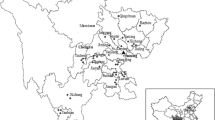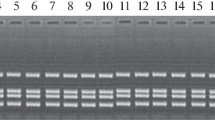Summary
Six fast-growing soybean rhizobia (Rhizobium fredii) and thirteen slow-growing soybean rhizobia (Bradyrhizobium japonicum) were examined for resistance to 10 antibiotics. Axenic studies were carried out to determine the competitiveness of dual-strain inocula consisting of fast- and slow-growing rhizobia isolated from subtropical-tropical soils for nodule occupancy on a hybrid of Asian and US soybean cultivars. Nodule occupancy was determined by intrinsic resistance to erythromycin and neomycin. The results showed wide variability in resistance to 10 antibiotics for fast- and slow-growing rhizobia. The intrinsic antibiotic resistance of fast- and slow-growing rhizobia was extremely high against nalidixic acid (400 μg ml−1) and penicillin (200 μg ml−1). The competitive ability of inoculant strains for nodule occupancy varied for different combination sets and with the plant growing media. Our results show that fast-growing rhizobia nodulate a hybrid of Asian and US soybean cultivars. Fast-growing soybean rhizobia did not completely exclude nodulation by the slow-growing strains, which formed 0–79% nodules, depending on the strain used in the inoculum.
Similar content being viewed by others
References
Bohlool BB, Kosslak R, Woolfenden R (1984) The ecology of Rhizobium in the rhizosphere survival, growth, and competition. In: Veeger C, Newton WE (eds) Advances in nitrogen fixation research. M Nijhoff/Dr W Junk Publishers, The Hague and Pudoc, Wageningen, pp 287–293
Caldwell BE, Vest G (1968) Nodulation interaction between soybean genotypes and serogroups of Rhizobium japonicum. Crop Sci 10:19–21
Chao CC (1987) Antibiotic and pesticide resistant characteristics of indigenous rhizobia in Taiwan. J Chin Agri Chem Soc 25:308–317
Cole MA, Elkan GH (1973) Transmissible resistance to penicillin G, neomycin, and chloramphenicol in Rhizobium japonicum. Antimicrob Agents Chemother 4:248–253
Cole MA, Elkan GH (1979) Multiple antibiotic resistance in Rhizobium japonicum. Appl Environ Microbial 37:867–870
Danso SKA, Habte M, Alexander M (1973) Estimating the density of individual bacterial populations introduced into natural ecosystems. Can J Microbiol 19:1450–1451
Dowdle SF, Bohlool BB (1985) Predominance of fast-growing Rhizobium japonicum in a soybean field in the People's Republic of China. Appl Environ Microbiol 50:1171–1176
Hagedorn C (1979) Nodulation of Trifolium subterraneum L. by introduced rhizobia in Southwest Oregon soil. Soil Sci Soc Am J 43.515–519
Hung AT (1987) The development and response of a new soybean variety Kaohsiung-8. Kaohsiung Agricultural Station, Pingtung, Taiwan
Josey DP, Beynon JL, Johnston AWB, Beringer JE (1979) Strain identification in Rhizobium using intrinsic antibiotic resistance. J Appl Bacteriol 46:343–350
Keyser HH, Bohlool BB, Hu TS, Weber DF (1982) Fast-growing rhizobia isolated from root nodules of soybean. Science 215:1631–1632
Kremer RJ, Peterson HL (1982) Nodulation efficiency of legume inoculation as determined by intrinsic antibiotic resistance. Appl Environ Microbiol 43:636–642
McLoughlin TJ, Owens PA, Alt SG (1985) Competition studies with fast-growing Rhizobium japonicum strains. Can J Microbiol 31:220–223
Schwinghamer EA, Dudman WF (1973) Evaluation of spectimomycin resistance as a marker for ecological studies with Rhizobium spp. J Appl Bacteriol 36:263–272
Stowers MD, Eaglesham ARJ (1984) Physiological and symbiotic characteristics of fast-growing Rhizobium japonicum. Plant and Soil 77:3–14
Vincent JM (1970) A manual for the practical study of root-nodule bacteria. International Biological Programme Handbook No 15, Blackwell Scientific Publications Oxford Edinburgh
Wacek TJ, Brill WJ (1976) Simple, rapid assay for screening nitrogen-fixing ability in soybean. Crop Sci 16:519–522
Yelton MM, Yang SS, Edie SA, Lim ST (1983) Characterization of effective salt-tolerant, fast-growing strain of Rhizobium japonicum. J Gen Microbiol 129:1537–1547
Young CC, Chao CC (1983) Legume production and application of Rhizobium in Taiwan. In. Proceedings of ROC-JAPAN seminar of promoting nitrogen fixation in agriculture. National Science Council of Republic of China Taipei, pp 39–44
Young CC, Chao CC (1988) Determination of generation time and symbiotic characteristics for Taiwan fast-growing soybean rhizobia. J Chin Agric Soc 143:27–37
Young CC, Wu MH, Chao CC (1982) The selection and use of Rhizobium in Taiwan. Food Fert Tech Cent, Tech Bull 66:1–9
Young CC, Chang JY, Chao CC (1988) Physiological and symbiotic characteristics of Rhizobium fredii isolated from subtropical-tropical soils. Biol Fertil Soils 5:350–354
Author information
Authors and Affiliations
Rights and permissions
About this article
Cite this article
Young, C.C., Chao, C.C. Intrinsic antibiotic resistance and competition in fast- and slow-growing soybean rhizobia on a hybrid of Asian and US cultivars. Biol Fert Soils 8, 66–70 (1989). https://doi.org/10.1007/BF00260518
Received:
Issue Date:
DOI: https://doi.org/10.1007/BF00260518




